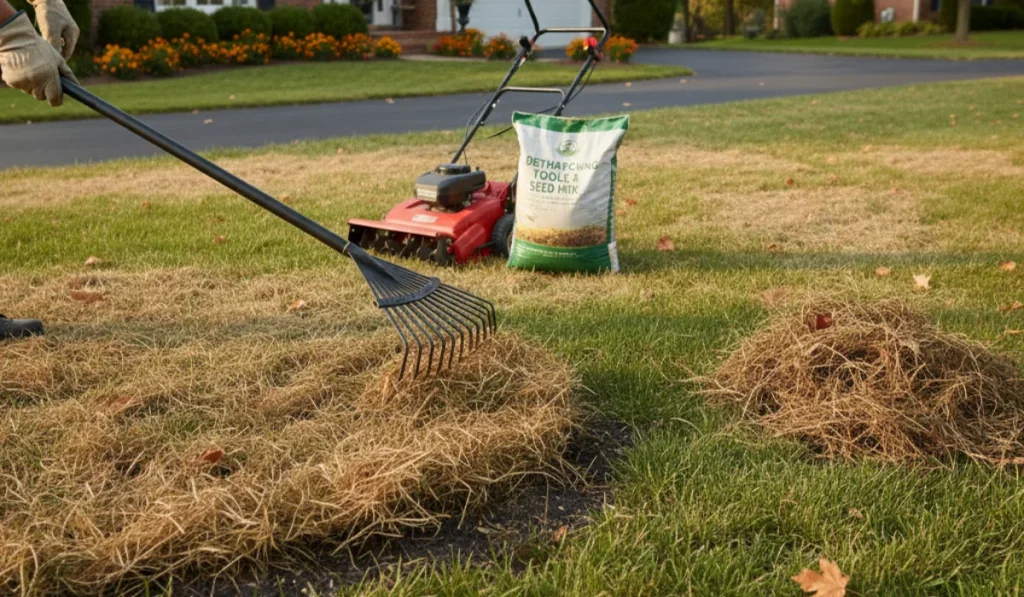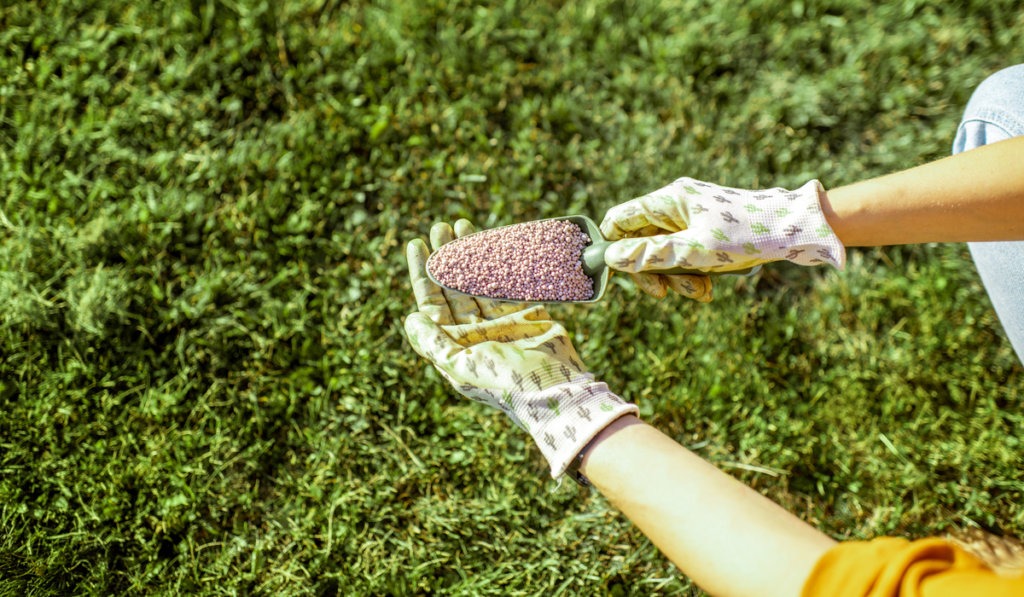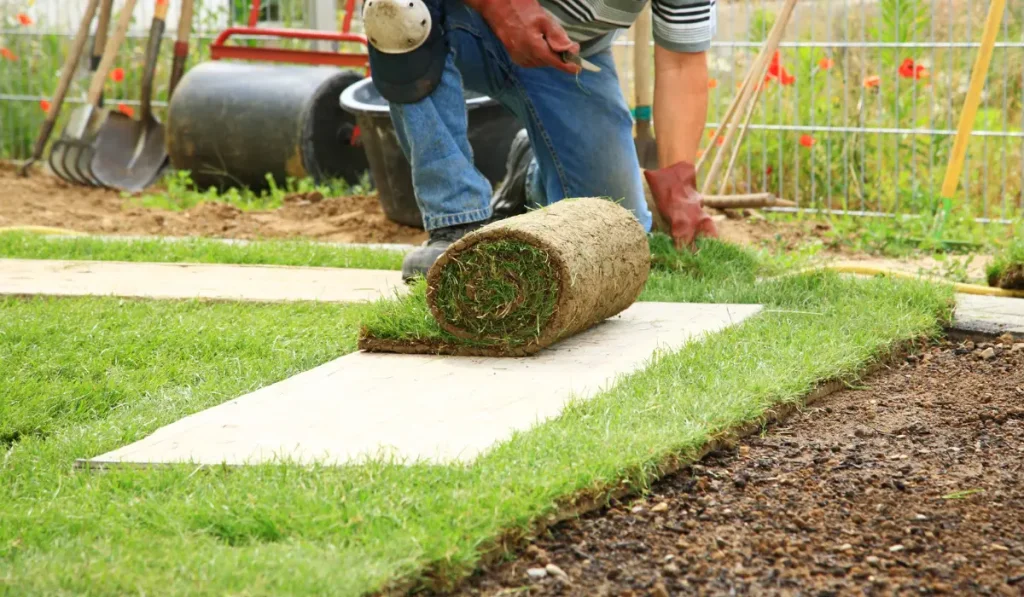Laying sod is a big step toward a healthy lawn, but without the right fertilizing strategy, new grass can easily become stressed or scorched. If you’re a homeowner fertilizing for the first time or managing a large-scale sod lawn, it’s essential to apply the correct type of fertilizer at the right time.
This article guides you through the process of fertilizing new sod without burning it, offering tips tailored to California’s diverse climate, ranging from foggy coastal cities to dry inland valleys.
Key Takeaways
- A soil test gives you the right starting point for choosing fertilizer based on your lawn’s nutrient needs.
- A starter fertilizer with a balanced NPK ratio supports early root growth without burning new sod.
- Granular slow-release fertilizer and proper watering help protect new grass during early establishment.
- Seasonal timing, mowing, and delayed weed control keep your new sod healthy and growing strong.
Start With a Soil Test Before You Fertilize
Before applying fertilizer for the first time, always conduct a soil test to determine the specific needs of your soil. It’s the foundation of responsible lawn care. The test will tell you how much phosphorus and potassium your topsoil needs, along with your soil’s pH.
This step is essential for any sod installation. Skipping it can lead to overfertilization, poor root growth, or even weed problems.
Whether you’re planting grass seed or laying sod, understanding your soil profile enables you to select the most suitable fertilizer for your specific conditions.
Most California homeowners can get results through a county extension office or a landscaping supply center.
Choose a Starter Fertilizer With the Right NPK Ratio
When you’re ready to fertilize new sod, choose a starter fertilizer with a balanced NPK ratio. That’s the mix of nitrogen (N), phosphorus (P), and potassium (K).
A good starter blend with fertilizer numbers like 15-15-15 or 16-16-16 supports strong root system growth and encourages new grass to thicken up quickly.
Different types of grass have varying nutrient requirements.
For example, cool-season grasses, such as bluegrass or tall fescue, require more nitrogen in early spring, while warm-season grasses, like zoysia or Bermuda grass, respond best in late spring and summer.
Always match your NPK selection to your lawn’s growing season and grass type.
Wait for Root Establishment After Sod Installation
It’s tempting to fertilize right after laying sod, but patience is key.
Your new lawn needs time to establish a solid root system before it can effectively absorb nutrients. Applying fertilizer too soon can burn the tender roots and stress your turf.
You’ll know your new sod is ready when you gently tug on a section and feel resistance. This typically occurs around two to three weeks after sod installation, depending on the weather and watering conditions.
This stage of root development is critical.
Avoid walking on the grass or using your mower until it’s well anchored.
Use Granular Slow-Release Fertilizer for Gentle Feeding
Once the sod is rooted, use a granular slow-release fertilizer to feed it gradually over time. Unlike liquid fertilizers, which can act too quickly and increase the risk of burning, granular blends deliver nutrients at a steady pace.
Use a spreader to ensure an even application of fertilizer.
Most products are labeled with coverage rates in square feet or “sq. ft,” so check the bag and match it to your sod lawn’s size. Accurate coverage is crucial for new sod care, as uneven application can result in patchy areas.
Water New Sod Immediately After Fertilizing
Watering is a must after any fertilizer application.
Not only does this activate the nutrients, but it also helps wash fertilizer particles off the grass blades, reducing the risk of leaf burn, whether you’re using a hose, a sprinkler, or an automated irrigation system. Water deeply enough to reach the top few inches of soil.
Don’t overwater, though. Too much water washes away nutrients and encourages the growth of fungus.
In California’s climate, where drought and overwatering are both concerns, follow a consistent watering schedule tailored to your time of year and turf needs.
Mow New Sod Only After the Grass Is Established
Mowing too soon can lift or damage your new sod.
Once the grass reaches 3 to 4 inches tall and is firmly rooted, it’s safe to mow. Use a sharp mower blade and remove only the top third of the grass blades at a time to reduce stress.
Cool-season grasses like fescue or bluegrass may need earlier mowing in spring, while warm-season grasses like Bermuda grass benefit from slightly lower cuts in summer.
Whether you use a rotary mower or a reel mower, be gentle and keep the mower height set to avoid scalping.
Adjust Based on Your Growing Season and Lawn Goals
In California, timing your fertilizer around your grass type’s growing season is key.
For warm-season grasses like St. Augustine or Zoysia, the ideal time is late spring to early fall. Cool-season types, such as fescue and bluegrass, respond best in early spring and late fall.
After the first application, watch how your lawn reacts.
If your new lawn stays green and grows evenly, you’re on track. If not, you may need to adjust your NPK ratio or switch from a conventional fertilizer to an organic one to minimize stress on your turfgrass.
Consider Weed Control and Lawn Health Later in the Season
Weed control should be postponed until your sod lawn is well established. Using herbicides or pre-emergent products too early can interfere with root development.
Focus on watering, mowing, and fertilizing until your sod has fully taken hold.
Later in the growing season, you can plan for aeration or overseeding to improve density and repair bare spots. These are good care tips for year-two landscaping once your lawn has matured.
Frequently Asked Questions
Can I use compost instead of fertilizer on new sod?
Compost improves topsoil health by adding organic matter and enhancing moisture retention, but it doesn’t provide the balanced nutrients that new sod needs. Use compost in conjunction with a starter fertilizer, not as a substitute for it.
How long should I wait to walk on newly fertilized sod?
Wait at least 48 hours after fertilizing and watering before walking on the lawn. This allows nutrients to settle into the soil and prevents soil compaction, which could slow down root development.
Does the type of spreader matter for applying new sod fertilizer?
Yes, the spreader you use affects accuracy. A broadcast spreader efficiently covers large areas, while a drop spreader offers better control along edges, in narrow spaces, and around landscaping features such as flower beds.



